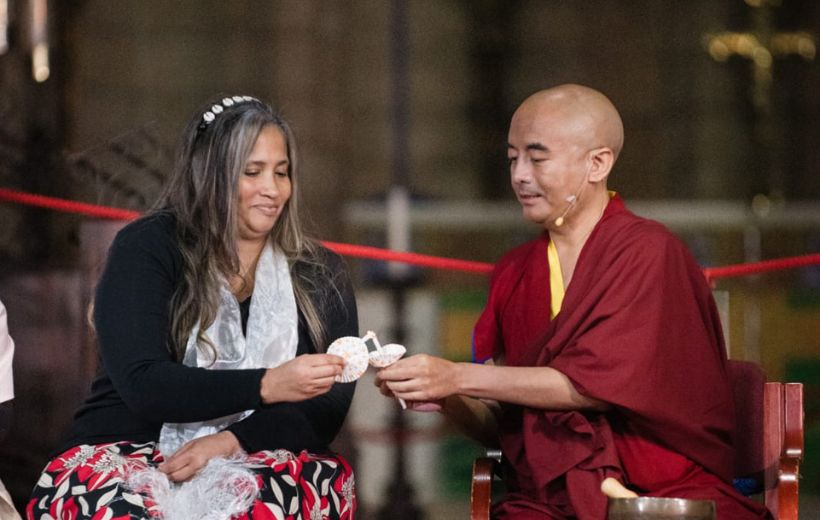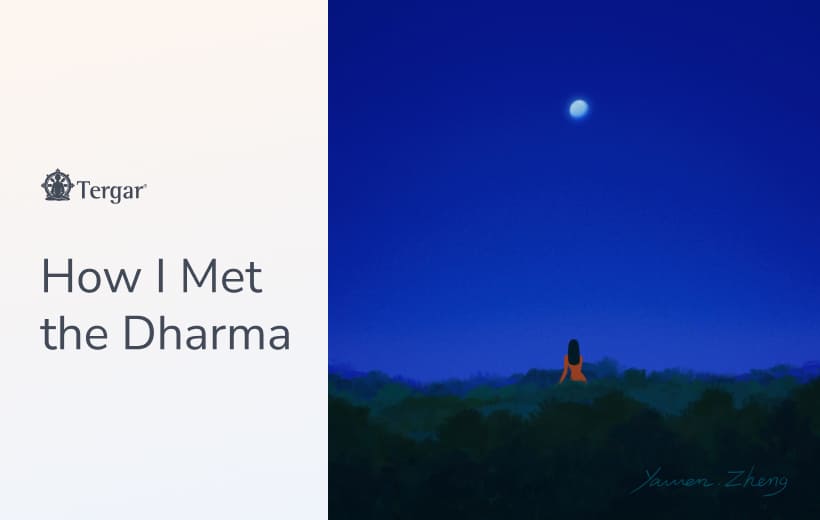Becoming Familiar with Who We Are
By Antonia Sumbundu • 3 min read

When thinking about the signs of progress along the meditation path, I first ask the question, “Why is it that we practice?” If we know our reasons, we can see if we are going in the direction we intend.
So, why do we practice? Here, we can consider what Mingyur Rinpoche refers to as dukkha. It can refer to a level of dissatisfaction or, more overtly, to what we would experience and call “suffering.” It’s a continuum.
Sometimes, we may be practicing meditation because there is a sense of something being quite “off” in our lives. Sometimes, it’s like a desperation that we feel. Maybe we feel stuck, and we’ve tried to go in this direction, and that direction, and all our strategies to be at ease with our situation haven’t worked. Or we are tired because we spend so much time and energy living in the future, hoping that things will get better. So we’re leaning forward with the idea: “Next week, next year, things will be better!” Fundamentally, we’re never at ease. It’s very exhausting never to be okay where we are.
Often, the problem is that we don’t really know who we are because we’ve never really spent time with ourselves. We’ve spent time with our ideas about who we should be or our fears about who we don’t want to be. We spend time with all these thoughts and images or outwardly focus on everybody else in the world. Deep down, there is this sense of hollowness because we don’t really know who we are. That’s the dukkha again.
One of the things that meditation practice does, and I see as a sign of progress, is that we begin to spend time with ourselves. We begin to know ourselves. In a way, it’s a mixed pleasure. On one hand, we may begin to get in touch with ways we can just “be.” We may get in touch with moments when the mind or body is at ease. We may get in touch with inwardly generated happiness because we have this capacity for recognizing wholeness. We have this capacity for contentment! When we begin to be in touch with these moments, we know we are moving in the right direction.
It may be in really simple moments when we experience what relaxation means physically. It may be like, “Wow, so that’s what they’ve been talking about! That’s what they mean when they say, ‘You should relax.’” We begin to get in touch with some of these qualities. This will happen in practice because we let go of some of the striving and busyness. Then, these qualities begin to become visible, and we begin to get in touch with them.
We get in touch with moments where things are a little bit simpler — when everything is no longer a big, long problem-solving process that we have to overthink. There begin to be moments of simplicity in our lives. So that’s, of course, really wonderful, and this is what we enjoy. But we also see our patterns much more. We also see how our attention is flickering, how the mind is scattered, and how our burdens affect us. This can be challenging! Perhaps we even get in touch with more pain because we’ve been using a lot of strategies to avoid feeling the dukkha.
We also begin to feel more; for some, that’s not so pleasant. That can be intense because you feel the pain of your situation. You feel the pain of the world. It all just tells us also that we’re coming a little bit more alive and a little bit more in touch with the nowness of our situation. We’re not so much in a fantasy somewhere else, but we’re just a little bit more alive and a little bit more in touch with what is happening right here and now.
The other thing that happens is that we also begin to get more control: it’s no longer random where our attention is. We’re actually able to let our intention decide what we pay attention to. So, that’s a shift from when our habits are leading, and our impulses pull us along to when our intention guides us a bit more. Deep down, I think that’s really what we wish, isn’t it? We wish to live a life where our intentions and values drive the bus more than all our habits.
As we progress along the meditative path, we may get in touch with some of our innate qualities. For instance, we may touch on the quality of spaciousness, the quality of openness, or the quality of compassion.
This also means when our mind is really narrow, these qualities can help us. There’s a merging that begins to happen. So even though we are who we are, and you know, we can get sad, angry and frustrated, but maybe there is a little more kindness in the mix and a bit more spaciousness for ourselves. Even if I’m unhappy now. Even if I feel bad, I know that it’s not the only way I can be and that it’s not all of me. There’s a little bit more space for our experiences, which makes a big difference in our lives.
One of the signs of practice is that it’s not as heavy. It can still be intensely painful, but it’s not heavy and closed in the same way. Life is not just fixed but begins to be more open. The future is more open. The past is more open, and the present is more open. That sense of greater openness — therefore more aliveness — makes it possible for us to be more skillful in our responses. We’re not reacting out of the patterns that often drive us because we’re more in touch with ourselves. We’re more in touch with the situation.
And it’s not like, in a very idealistic way, that we’re just perfect. We’re not, and we’re not even waiting for the moment when we will be perfect. We are more okay with being where we are and understanding, “Yes, this is where I am, and this is the situation I’m in.” We accept that, and we relate to that — bit by bit, more space or the light seeps in. I’m reminded of one of the traditional images: you have this cover over a window, and then you poke a hole through the cover, so gradually, more and more light can come in, and things begin to loosen, and we become freer.

Antonia Sumbundu is an instructor for the Tergar Meditation Community, a clinical psychologist, and a mental health specialist. She has been practicing meditation for over 35 years and has had the good fortune to practice and study with many great teachers, including Chokyi Nyima Rinpoche, Chokling Rinpoche, and Tsoknyi Rinpoche. In 2002, she met Mingyur Rinpoche and began to receive teachings from him. She leads retreats, teaches, and supports practice groups internationally, and she is the Program and Clinical Director of a series of Accredited Psychotherapy Training Programs.
Learn meditation under the skillful guidance of world-renowned teacher Yongey Mingyur Rinpoche at your own pace.


The spirit of boundless compassionate Ubuntu filled the St George’s Cathedral in Cape Town, South Africa on Mingyur Rinpoche’s first-ever visit to the continent.

Scott Alexander Jones, a self-described “stone-cold atheist hardened against religion” finds the spiritual path through the eye-opening discoveries of science that is validating the many benefits of meditation.

Like the mind, the Earth is imbued with resilience, enabling it to return to harmonious equilibrium if only we allow it enough time undisturbed.
If you enjoyed reading our articles, please join our mailing list and we’ll send you our news and latest pieces.